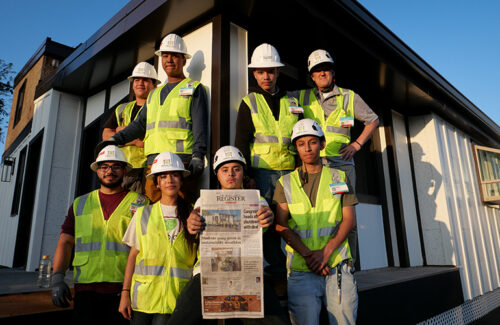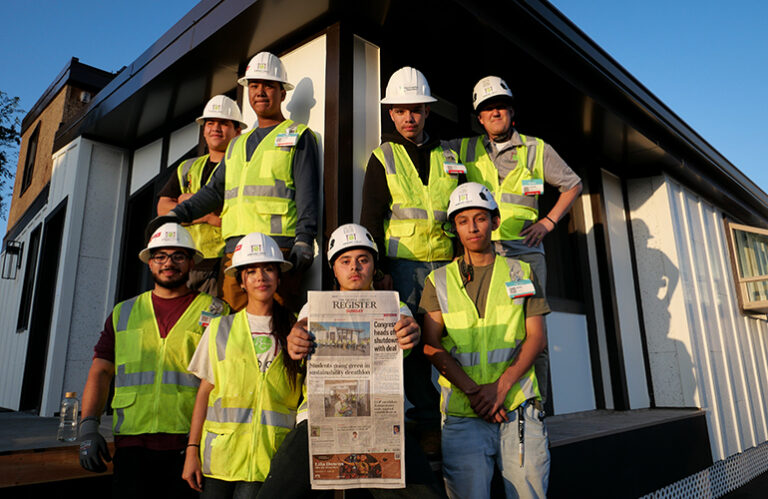A Monterey County Superior Court judge in California was tired of seeing young people walking through his courtroom on their way to jail. So in 2000, he founded Rancho Cielo School to provide general education and curriculum in a range of professions to marginalized youth. The school in Salinas, California, hosts programs in culinary arts, auto repair and construction and has changed the lives of many at-risk youth in the area.
23 years later, a group of Rancho Cielo high school students from the Construction & Sustainable Design Academy (CSDA) achieved a historic feat by winning the award Orange County Sustainability Decathlon, with higher marks than 13 other teams from universities around the world. In 2023, they built an off-grid solar + storage home called Nexus 01, dominating the competition and learning about their personal potential.
Creating the future home with traditional materials
Thomas Rettenwender, founder and director of Ecologic Architects, former teacher and current board member of Rancho Cielo, had heard about the decathlon and presented the idea of the school participating in the competition.
“The timing was right because we were coming out of the pandemic and there was a desire for a restart,” he said. “We had all this pent-up energy to get carried away, to make a difference.”

Students from Rancho Cielo’s Construction & Sustainable Design Academy stand in front of Nexus 01, an off-grid modular home they built that was the overall winner of the 2023 Orange County Sustainability Decathlon. OCSD
Decathlon competitors were tasked with building solar-powered homes that would be both environmentally friendly and provide solutions to California’s housing crisis. Each entry was judged against 10 different criteria, including construction, design, sustainability and overall message.
Rettenwender designed a two-story modular home intended for solar panels, energy storage and many other sustainable appliances, such as air filtration units. CSDA students were familiar with building smaller projects, such as portable toilets and tractor sheds, but they had never tackled a construction project with the scope of Nexus 01.
“These are kids from the streets, and when we started the project, some of them didn’t know how to pick up a hammer – literally,” said Pete Scudder, president of Scudder Solar Energy Systems and Scudder Roofing, which oversaw the roofing and solar installation on the project.
Scudder said it took some time for the children to become comfortable with building a project of this size. They were divided into groups and assigned to a respective field to perform electrical and solar installation, roofing, plumbing, carpentry, tiling and managerial functions.
“We sat down and said we were going to build a house out of the traditional materials that our students need to understand how to put together to get a job in today’s market,” said Bill Hayward, CEO of Hayward Lumber and construction consultant. on Nexus 01. “We thought about these things in a way that we thought the industry could replicate tomorrow, because we need affordable housing tomorrow.”
The frame of this 850 ft2 The house is made of Douglas fir and the exterior is wrapped in fire-resistant cork, eliminating the need for insulation and siding. The envelope is designed to be airtight and uses filtration units to allow fresh air to flow into the building every two hours. Solar energy powers all electrical appliances and utilities.
The house was designed to optimize solar energy generation by deviating from a traditional facade profile and instead placing both parts of the roof on a single south-facing slope. A 7.4 kW solar array is powered by Maxeon 3 panels with Enphase IQ8A microinverters charging two Enphase Encharge 10 batteries donated by Scudder Solar.
“If you retrofit solar energy to a house, the roof will not be optimal. You just have to work with what you have,” Rettenwender said. “But if you design a house that is exposed to the sun, then you have more opportunities.”
Students built the house over the course of a year at Rancho Cielo. As fall 2023 approached, the building was dismantled and prepared for rebuilding at the OC Fair & Event Center in Costa Mesa, a five-hour drive south of Salinas.
Competition time
The Nexus 01 was transported to the fairgrounds on four semi-trucks. Once unloaded, Rancho Cielo had two weeks to reassemble the building and ensure everything was functioning properly both inside and out. They were the first of fourteen participants to arrive and needed every minute to rebuild. Scudder was on the phone with Enphase attempting to commission the system and completed it while the OCSD judges walked to the building.

Nexus 01 was initially built on the Rancho Cielo campus in Salinas, California, and was shipped to the OC Fair & Event Center in Costa Mesa, where it was rebuilt. The project includes a 7.4 kW rooftop solar array with battery backup. OCSD
When the judging started and the results were announced, the students realized that the Nexus 01 was a contender. Their building placed in eight of the ten categories, with five first places and being named the overall winner of the competition. Later they presented Nexus 01 in an auditorium to a crowd of 200 people.
“These kids wouldn’t even look at me at first two years ago. Now they’re standing up there,” Scudder said. “It changed their self-esteem and how they thought about themselves and how they thought about others, and they realized that they can compete in the global marketplace.”
Nexus 01 was a proof of concept. It proved that it was possible to build a sustainable home without the need for space-age technology or non-traditional materials. Rancho Cielo and Ecologic Architects are now in the process of starting Nexus Housing, an organization that will continue to build homes in the style of the Nexus 01 prototype with the continued help of students and consultants.
The project also proved the capabilities of young minds when given the tools they need. From this experience, Scudder hired five of the students who worked on the Nexus 01 project.
The house will soon be rebuilt at Rancho Cielo as a permanent fixture. Visitors to the school will have the opportunity to see the programs in action, enjoy a meal at the Drummond Culinary Academy and stay overnight in sustainable housing.
“When builders say it’s too hard to do, they think: Really? Because high school students can do it,” Hayward said.


